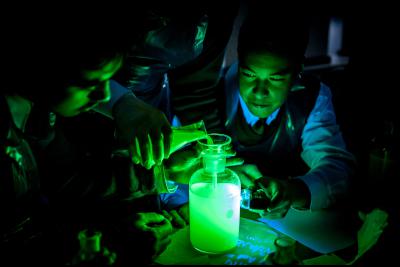Science in te reo Māori - Akoranga pūtaiao i roto i te reo

Kura and
fluorescence
Akoranga pūtaiao i roto i te reo Māori
Viewing eyeballs through a microscope and discovering the huge numbers of cells in a “single eyeball slice” was one of the highlights for Te Kura Kaupapa Māori o Ngā Mokopuna students on a recent visit to the University of Otago, Wellington.
In a day of science held primarily in te reo Māori, Year 9-11 students from the kura returned for a third year, but this time they dissected eyeballs and lit up the lab with fluorescence.
Dr Sara Filoche who led the science teaching and experiments with Ruruhira Rameka supporting with te reo Māori, says that other kura from around the Wellington region are keen to get involved as well.
“We would like to offer other kura the same opportunity. I have spoken with other kaiako who have said there are a lot of one-off opportunities, but to be able to have a committed programme that contributes to NCEA credits would be a significant contribution to science teaching for Māori,” says Dr Filoche.
Year 10 student Christian Mauriri, from Te Kura Kaupapa Māori o Ngā Mokopuna wrote about the day in te reo Maōri and English:
“Te Tūhura i te Karu me te Kōrekoreko
I te tau nei i waimarie mātou ngā tauira tau 9-11 o Te Kura Kaupapa Māori o Ngā Mokopuna ki te haere ki te awheawhe pūtaiao o Te Whare Wānanga o Ōtākou ki reira ako ai i ngā mahi o te pūtaiao e aro ana ki te karu o te kau, te karu o te tangata, te pūrama kōrekoreko anō hoki. Ko te wahanga e pai ana ki ahau ko te tūhura ki roto i ngā karu whārahi kia kite ai i te miriona o ngā pūtau i roto i tētahi wāhanga iti o te karu o te tangata. He mīharo hoki te whakamahi i te pene muramura ki te waitohu i tētahi pepa me te whakamahi i te pūrama aho katikati ki te kite i te po.”
“Exploring the Eye and Fluorescence
This year I, along with the year 9-11 students of Te Kura Kaupapa Māori o Ngā Mokopuna were fortunate enough to go to the University of Otago, Wellington Campus where we explored, and discovered things about the eye of a cow, and the human eye. We also used a UV light to examine things in the dark. My favorite part of the whole experience was when we examined a human eye through a microscope. I was amazed to see how many cells are in a single slice of an eye. Another highlight was when we signed a paper with a highlighter pen and used the UV light to see it in the dark.”
“This was another successful and engaging day, these guys really honed their dissection skills – text book, and we’ve saved the annotations in Māori for others to learn from. We would love to offer others this opportunity and need to find a way to make it happen and ensure it can be sustainable and ongoing for others too,” says Dr Filoche.
The University of Otago,
Wellington’s Pathology Department will be also holding an
open day in November to celebrate International Pathology
Day.


 International Writers' Workshop NZ Inc: Ōtepoti Poets Top The Kathleen Grattan Prize For A Sequence Of Poems
International Writers' Workshop NZ Inc: Ōtepoti Poets Top The Kathleen Grattan Prize For A Sequence Of Poems NZ Amateur Sport Association: 22 Amendments Proposed For 2022 Act Lodged On 22 November
NZ Amateur Sport Association: 22 Amendments Proposed For 2022 Act Lodged On 22 November Auckland University of Technology: Reading Helps Children Face A Difficult Future
Auckland University of Technology: Reading Helps Children Face A Difficult Future PATHA: Puberty Blocker Evidence Brief Affirms Aotearoa’s Approach
PATHA: Puberty Blocker Evidence Brief Affirms Aotearoa’s Approach Tataki Auckland Unlimited: Into Ocean & Ice - Unveiling Antarctica's Past And Present
Tataki Auckland Unlimited: Into Ocean & Ice - Unveiling Antarctica's Past And Present Health Coalition Aotearoa: Urgent Action Needed To Address Aotearoa’s Shameful Household Food Insecurity
Health Coalition Aotearoa: Urgent Action Needed To Address Aotearoa’s Shameful Household Food Insecurity